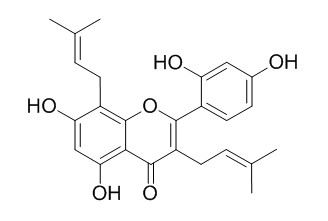Mulberrin
Mulberrin is a strong inhibitor of organic anion-transporting polypeptide 2B1 (OATP2B1)-mediated estrone-3-sulfate (E3S) uptake with an IC50 value being 1.8 ±1.5 μM; it also as HIV-1 reverse transcriptase inhibitor. Mulberrin has significantly reduced role on blood sugar of type II diabetes model of rats.
Inquire / Order:
manager@chemfaces.com
Technical Inquiries:
service@chemfaces.com
Tel:
+86-27-84237783
Fax:
+86-27-84254680
Address:
1 Building, No. 83, CheCheng Rd., Wuhan Economic and Technological Development Zone, Wuhan, Hubei 430056, PRC
Providing storage is as stated on the product vial and the vial is kept tightly sealed, the product can be stored for up to
24 months(2-8C).
Wherever possible, you should prepare and use solutions on the same day. However, if you need to make up stock solutions in advance, we recommend that you store the solution as aliquots in tightly sealed vials at -20C. Generally, these will be useable for up to two weeks. Before use, and prior to opening the vial we recommend that you allow your product to equilibrate to room temperature for at least 1 hour.
Need more advice on solubility, usage and handling? Please email to: service@chemfaces.com
The packaging of the product may have turned upside down during transportation, resulting in the natural compounds adhering to the neck or cap of the vial. take the vial out of its packaging and gently shake to let the compounds fall to the bottom of the vial. for liquid products, centrifuge at 200-500 RPM to gather the liquid at the bottom of the vial. try to avoid loss or contamination during handling.
J Ginseng Res.2022, 46(1):104-114.
J Basic Clin Physiol Pharmacol.2016, 27(1):1-8
Cell J.2024, 26(8):496-504.
Front Plant Sci.2022, 13: 905275.
Chemistry of Natural Compounds2018, 54(3):572-576
Revista Brasileira de Farmacognosia2024, 34:1156-1165.
Int J Mol Sci.2024, 25(17):9730.
Food Res Int.2020, 133:109130.
J Biol Chem.2014, 289(3):1723-31
Int J Mol Sci.2018, 19(9):E2601
Related and Featured Products
Bioinformation. 2012;8(24):1206-10.
Virtual screening of Indonesian herbal database as HIV-1 reverse transcriptase inhibitor.[Pubmed:
23275721]
HIV-1 (Human immunodeficiency virus type 1) is a member of retrovirus family that could infect human and causing AIDS disease. AIDS epidemic is one of most destructive diseases in modern era. There were more than 33 million people infected by HIV until 2010. Various studies have been widely employed to design drugs that target the essential enzymes of HIV-1 that is, reverse transcriptase, protease and integrase.
METHODS AND RESULTS:
In this study, in silico virtual screening approach is used to find lead molecules from the library or database of natural compounds as HIV-1 reverse transcriptase inhibitor. Virtual screening against Indonesian Herbal Database using AutoDock4 performed on HIV-1 reverse transcriptase.
CONCLUSIONS:
From the virtual screening, top ten compounds were Mulberrin, plucheoside A, vitexilactone, brucine N-oxide, cyanidin 3-arabinoside, alpha-mangostin, guaijaverin, erycristagallin, morusin and sanggenol N.
Journal of Traditional Chinese Medicine University of Hunan, 2011, 31(5):26-8.
Experimental study of mulberrin on blood glucose of Type Ⅱ diabetes model rats.[Reference:
WebLink]
The experiment had investigated the results by using Mulberrin on blood glucose,insulin,glycated hemoglobin,glucose tolerance of Type II diabetes model rats.
METHODS AND RESULTS:
According to Chinese herbal medicine research guide(oral) pharmacodynamics experiment demands,choose the normal mice(KM mice),spontaneous diabetic mice(NOD mice) and chain fosomycin heightening urea to heat feed type II diabetes rats,fill the stomach give different doses of mulberry element,research on the blood glucose,insulin,glycated hemoglobin influence.1.The concentration of blood glucose of regular lab rats has no visibly changed(P0.05)after using Mulberrin of 50.0,25.0,12.5 mg/kg by oral administration for 14 days.By contrast,the blood glucose were obviously lower and rates of Insulin were obviously higher(P0.05) in NOD rats.2.The concentration of blood glucose of has reduced obviously after using Mulberrin of 30.0,15.0,7.5 mg/kg).Compare with the regular group,the rates of Insulin and Glycosylated Hemoglobin were obviously lower(P0.05) after using Mulberrin of 30,15 mg/kg by oral administration for 14 days.
CONCLUSIONS:
Mulberrin has significantly reduced role on blood sugar of type II diabetes model of rats.
Pharm Biol. 2016;54(2):293-302.
Identification of natural products as modulators of OATP2B1 using LC-MS/MS to quantify OATP-mediated uptake.[Pubmed:
25858254 ]
Organic anion-transporting polypeptide 2B1 (OATP2B1) which is highly expressed in enterocytes and hepatocytes could be a key determinant for the intestinal absorption and hepatic uptake of its substrate drugs. Natural products are commonly used in traditional Chinese medicine, foods, and beverages.
The objective of this study is to determine the OATP2B1-mediated drug interactions that could occur between natural products and OATP2B1 substrate drugs.
METHODS AND RESULTS:
Human OATP2B1 was transiently expressed in human embryonic kidney (HEK293) cells and characterized by immunofluorescence, Western blot, and uptake assay. Liquid chromatography-tandem mass spectrometry (LC-MS/MS) methods for detecting OATP2B1 substrates estrone-3-sulfate (E3S) and three statins had been developed and were employed to investigate the effects of 27 frequently used natural products on the function of OATP2B1. Uptake of 5 μM E3S and 1 μM statins in the absence or presence of natural products was measured at 37 °C for 2 min with empty vector- and OATP2B1-transfected HEK293 cells. The IC50 values of inhibitors for OATP2B1-mediated 5 μM E3S uptake were determined.
Our results showed that Mulberrin, scutellarin, quercetin, and glycyrrhetinic acid were strong inhibitors of OATP2B1-mediate E3S uptake with IC50 values being 1.8, 2.0, 7.5, and 13.0 μM, which were comparable with their plasma concentrations in clinical trials. They also inhibited OATP-mediated uptake of atorvastatin, fluvastatin, and rosuvastatin. These results indicated that clinically relevant drug interactions could occur between these natural compounds and OATP2B1 substrate drugs.
CONCLUSIONS:
The information obtained from this study might be helpful to predict and to avoid potential OATP2B1-mediated drug interactions.



